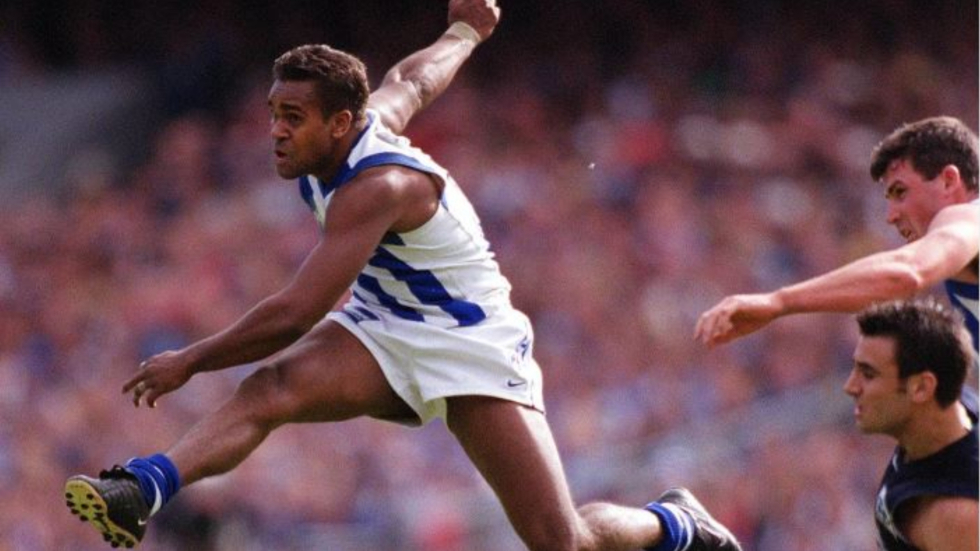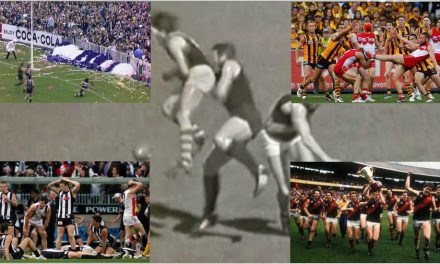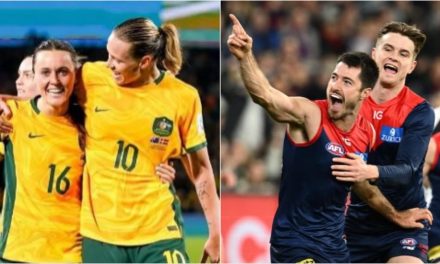Byron Pickett bursts clear for North Melbourne against Carlton in the 1999 AFL grand final. Photo: AFL MEDIA
Look away recruiters, because 1996 was a big swing and a miss for you guys.
Of the original top 10, only two players maintained their places in the Footyology Redraft – star Bulldogs and Richmond forward Nathan Brown, who jumped seven places from 10 to three, and No.1 pick Michael Gardiner, who slid down to six.
Upon revision, the new top pick from 1996 is three-club hard nut Byron Pickett, who was originally drafted at pick 67 by North Melbourne.
The thought of Pickett running full speed at the opposition ball carrier sent shivers down the spine of every player in the AFL for more than a decade – just ask poor old Brendan Krummel (at the 28-second mark).
But apart from being one of the most feared footballers of his generation, Pickett was also a spectacular player capable of brilliant and match-winning play, as evidenced by his Norm Smith Medal-winning performance in the 2004 grand final.
Pickett spent the majority of his career in defence, but could be thrown forward too, finishing with 177 goals from his 204 games, including two bags of six, and kicking 40 goals in a season twice (2002 and 2003).
He played for North Melbourne, Port Adelaide and Melbourne, winning a premiership with both the Kangaroos and Power, while also claiming the Rising Star in 1998 and earning All-Australian honours in 1999. He’s a member of the Indigenous Team of the Century, too.
Coming in at No.2 in the Redraft is superstar triple premiership defender Mal Michael.
Best known for his time at Brisbane, the man mountain also played for three clubs with stints at Collingwood and Essendon bookending his glittering career.
A cornerstone of the Lions’ feared and revered backline from their famous “three-peat” in 2001-03, Michael was originally picked up by the Magpies with pick No.6 in the AFL’s first ever rookie draft, which essentially amounted to pick 116.
So with a dramatic upgrade of 114 spots, Michael represents a serious bargain pick-up.
But Collingwood wouldn’t enjoy the fruits of its shrewd selection for very long, trading Michael to Brisbane after just four years in exchange for forward Jarrod Molloy.
PLEASE HELP US CONTINUE TO THRIVE BY BECOMING AN OFFICIAL FOOTYOLOGY PATRON. JUST CLICK THIS LINK.
It proved to be a fateful “sliding doors” moment for both players, as Michael went on to win three flags in his first three years at the Lions, two of which were against his former side Collingwood, while Molloy played in the losing 2002 grand final for the Pies.
Michael blossomed up in Queensland. Realising his full potential as one of the league’s best backmen, he was an absolute beast in defence for Brisbane, and one of the hardest match-ups for opposition forwards.
He ended up playing 238 games over 12 seasons.
Rounding out the top three is Brown, who was one of the most gifted goalsneaks and ball winners of his era.
After starting his career at the Bulldogs, it became quickly apparent how talented Brown was, and he ended up kicking 206 goals from 137 games for the Dogs in seven seasons, including back-to-back 50-goal years in 2002 and 2003.
He picked up consecutive All-Australian jumpers in 2001 and 2002, and just as he seemed to be at the peak of his powers, he stunned the Whitten Oval when he accepted a big-money offer from Richmond and linked up with his former Bulldogs coach Terry Wallace at Punt Road.
His star continued to rise with the Tigers, as he well and truly broke into the upper echelon of elite AFL players, before a gruesome leg injury against Melbourne in 2005 cruelly brought his momentum to a grinding halt.
Demons defender Matthew Whelan fell across Brown’s leg, badly breaking it, and Brown was never the same player again.
Triple premiership forward Cameron Mooney comes in at No.4, an upgrade of 52 spots after being taken at 56 by North Melbourne, while Essendon premiership star Jason Johnson completes the top five after also getting a nice promotion from pick 28.
Former West Coast and St Kilda ruckman Gardiner dropped from one to six, and high-flying Melbourne sharpshooter Russell Robertson skyrocketed 61 places from 68 to seven.
The significant upgrades don’t end there, though, with 2000 Brownlow medallist Shane Woewodin jumping from the 18th pick of the pre-season draft to pick No.8 – a promotion of 100 selections.
Dependable Adelaide full back Nathan Bassett rose 104 spots from pick three in the rookie draft to pick No.9, and another member of the 2000 Essendon premiership team, Mark Johnson, completes the top 10 after being catapulted 112 spots from the 12th selection in the rookie draft.
Special mentions also go to dual premiership Lion Tim Notting, Melbourne’s James McDonald, the Johnsons’ Essendon premiership teammate Chris Heffernan, Pickett’s fellow Port Adelaide flag winners Brett Montgomery and Adam Kingsley as well as St Kilda trio Andrew Thompson, Max Hudghton and Heath Black.
West Coast premiership midfielder Michael Braun, ex-Kangaroo and Docker Jess Sinclair, former Docker and Swan Troy Cook, and Hawthorn full back Jonathan Hay, who finished up at North Melbourne, missed out on selection in the 1996 Redraft top 10 too.
*Redrafts only consider the first time a player was drafted.












